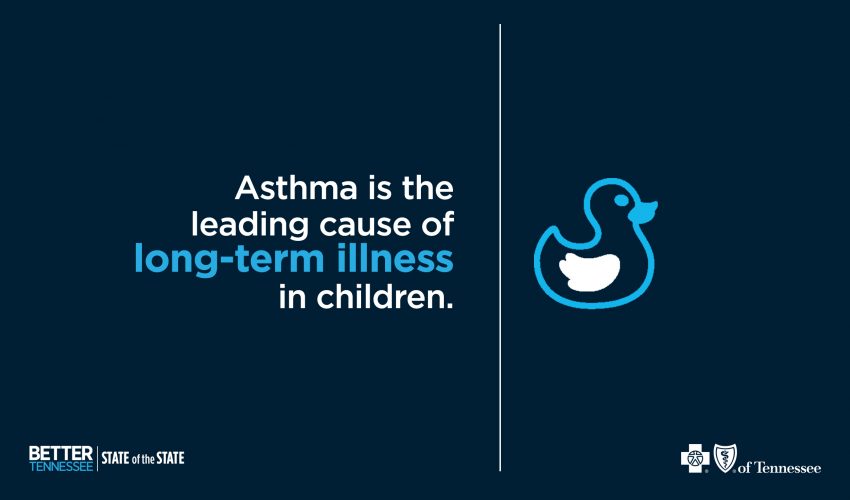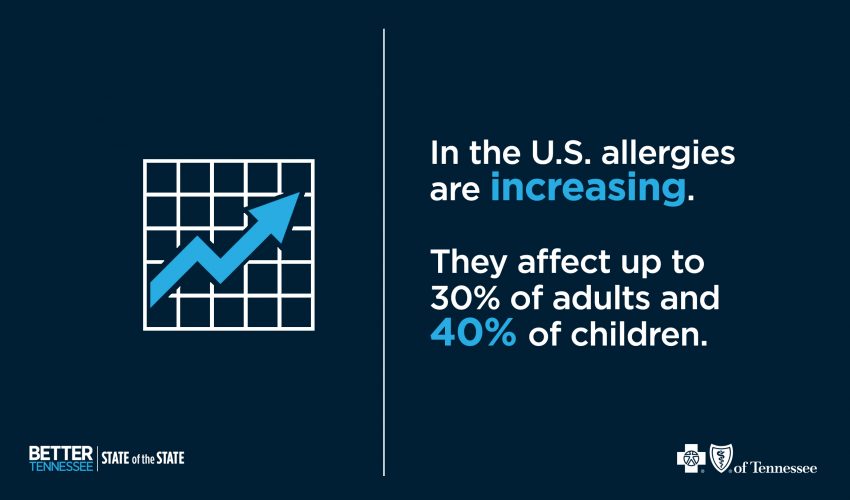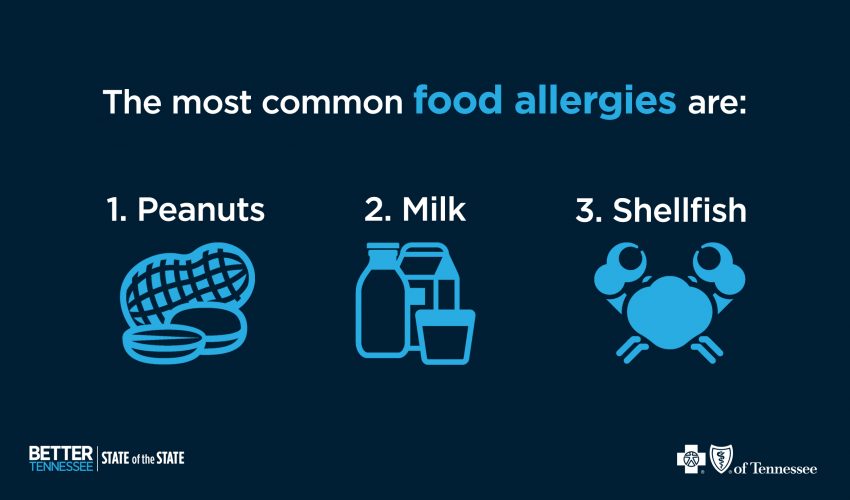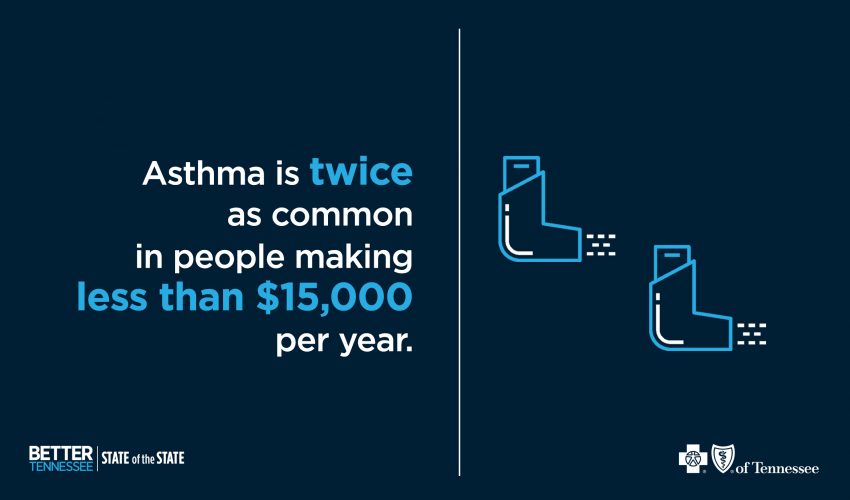Updated January 15, 2018
Health briefs offer quick but comprehensive information about some of the biggest health challenges Tennessee is facing.
Scroll down to read all about asthma and allergies in our state or jump to a specific section:
About 20 million Americans have asthma.
Asthma is the leading cause of long-term illness in children.
Allergies are the 6th leading cause of chronic illness in the U.S.
Allergies are increasing. They affect up to 30% of adults and 40% of children.
What is asthma?
Asthma is a chronic inflammatory lung disease.
During an attack, mucus clogs the airways, muscles tighten and the lining of the airways swells, making it difficult to breathe.
This can happen:
- After a viral infection
- During exercise or
- After exposure to triggers such as:
- Animal dander
- Dust mites
- Cockroach particles
- Pollen
- Tobacco smoke
- Air pollution
- Chemical irritants
- Mold
Symptoms of an episode include:
- Coughing
- Wheezing
- Chest tightness
- Difficult breathing
What are allergies?
Allergies are an overreaction of the immune system to substances (allergens) that don’t affect most people. They can cause sneezing, coughing and itching.
Allergic reactions range from annoying to life-threatening. Anaphylaxis is the most severe allergic reaction and can cause seizures, cardiac arrhythmia, shock, respiratory distress and even death.
Allergies and asthma often occur together. The same substances that trigger allergies may also cause asthma symptoms. In some people, skin or food allergies can cause asthma symptoms. This is called allergic asthma or allergy-induced asthma.
Allergic diseases
Allergic diseases occur when the immune system reacts against harmless substances.
The most common allergic diseases include:
- Hay fever (itchy, watery eyes; sneezing)
- Asthma
- Conjunctivitis (pink eye)
- Hives
- Eczema/dermatitis (red, itchy skin)
- Sinusitis
Food
Food allergies are most prevalent in young children and are frequently outgrown.
Eight foods cause most food allergy reactions:
- Peanuts (#1)
- Milk (#2)
- Shellfish (#3)
- Soy
- Eggs
- Wheat
- Tree nuts
- Fish
5.4% of U.S. children under age 18 suffer from food allergies.
Other
Other things that may cause allergies:
- Latex
- Bees, hornets, wasps, yellow jackets and fire ants
- Drugs such as penicillin
How prevalent are asthma and allergies?
Asthma
Asthma affects up to 10 million adults in the U.S.
In Tennessee, asthma affects 6% of adults and 9.5% of children.
Asthma is seen more often among children, females and those with family income below the poverty level.
Women
Asthma is more common among women than men, and women with chronic asthma face extra challenges due to menstrual cycles, pregnancy and menopause. Changing estrogen levels can cause attacks, which are also dangerous for pregnant women and fetuses since they deprive both of oxygen.
Poverty
The average prevalence of asthma among people with an income of less than $15,000 was more than double those with an income of $15,000 or more.
Asthma prevalence by income in Tennessee

Allergies
Seasonal
In 2016, the Allergy & Asthma Foundation of America included four metropolitan areas in Tennessee as places where pollen sufferers find it challenging to live:
For fall allergies:
- Memphis — No. 2
- Knoxville — No. 10
- Chattanooga — No. 22
- Nashville — No. 27
The spring allergy list ranks the cities in almost the same spots:
- Memphis — No. 2
- Knoxville — No. 9
- Chattanooga — No. 23
- Nashville — No. 29
The pollen season begins in Tennessee as early as February.
Calendar
A month-by-month breakdown of allergens in Tennessee includes:
- January: Pollen is low; dust mites are high
- February: Tree pollen returns; precipitation creates slush which breeds mold
- March: More tree pollen
- April: Peak season – precipitation bringing on allergies including tree, mold and grass pollen
- May: Tree pollen decreases; grasses do not
- June: Grass pollen remains high and summer rain storms increase mold
- July: Grass pollens decrease; hot, humid temperatures increase spores and seeds; summer air pollution and ozone clouds make symptoms worse
- August: Mold continues; ragweed begins to thrive
- September: Ragweed at maximum effect
- October: Fall showers cause mold; grasses come out of dormancy once more
- November: Ragweed and mold are present but decreasing
- December: Freezing winter temperatures should kill off many allergens and alleviate most symptoms
Children
8.4% of U.S. children suffer from hay fever.
10% of U.S. children have respiratory allergies.
Food
People visit the emergency room 200,000 times each year because of food allergies.
Skin
8.8 million children in the U.S. have skin allergies.
Medicine
Penicillin is the most common trigger for those with drug allergies.
Up to 10% of people report being allergic to penicillin.
Insect
Insect sting allergies affect 5% of the population.
Each year 90-100 deaths occur due to insect stings in the U.S.
Latex
1% of people in the U.S. have a latex allergy.
How do you prevent asthma and allergies?
Asthma
In most cases, the causes of asthma are unknown.
There is no cure; however, asthma can be controlled by:
- Knowing the warning signs of an attack
- Staying away from triggers, and
- Following a doctor’s advice, including using daily maintenance medication rather than relying only on rescue inhalers.
Allergies
Anyone may have or develop an allergy. Allergies generally cannot be prevented, but allergic reactions can be.
Successful management may include:
- Recognizing signs and symptoms
- Seeking diagnosis and treatment from medical providers
- Reducing or controlling exposure to environmental triggers
How is BlueCross addressing asthma and allergies?
Charitable and community programs
The BlueCross BlueShield of Tennessee Health Foundation has contributed to controlling asthma and allergies in Tennessee by:
- Supporting Healthier Tennessee, a broad public health initiative, with $3,750,000 in grants since 2013
- Supporting charitable clinics that diagnose asthma and allergies:
- With donations of more than $100,000
- Through a forum that led to the creation of Tennessee Charitable Care Network, which supports nonprofits that care for underserved Tennesseans
- Donating more than $58,000 to the American Lung Association
Member services and support
In addition to supporting charitable programs that benefit all Tennesseans, BlueCross also has programs in place to support members affected by allergies and asthma.
- BlueCross employs around 900 nurses, many of whom work directly with members.
- Care managers take a personalized approach to support and guide members with asthma or chronic allergies, using evidence-based guidelines and motivational interviewing to help members get better at managing their own conditions.
- BlueCross also uses data-driven outreach campaigns to help ensure members are getting the needed preventive and maintenance care.
Visit bcbst.com to learn more or access these services.
INFOGRAPHICS







